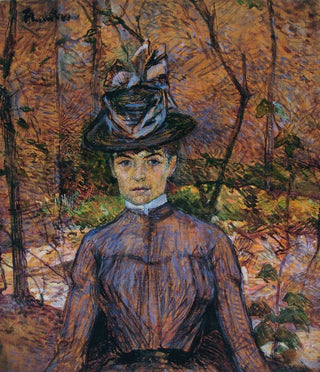Art print | Portrait of Suzanne Valadon - Henri de Toulouse-Lautrec


View from behind

Frame (optional)
The "Portrait of Suzanne Valadon" by Henri de Toulouse-Lautrec is an iconic artwork that embodies the very essence of the Belle Époque. This painting, created in 1896, highlights the renowned artist and model, Suzanne Valadon, who captured the attention of her era through her charisma and talent. Toulouse-Lautrec, known for his bold style and ability to depict Parisian life, offers here a striking representation of Valadon, blending intimacy and modernity. The vibrant composition and dazzling colors immerse us in a universe where art and life intertwine, inviting the viewer to explore the nuances of the human soul.
Style and uniqueness of the work
This portrait stands out for its unique approach and innovative technique. Toulouse-Lautrec uses energetic brushstrokes and bold colors to bring his subject to life. The way he captures Valadon's gaze, both direct and mysterious, creates an immediate connection between the viewer and the model. The stylized forms and accentuated contours reflect the influence of contemporary artistic movements, while maintaining a personal touch that makes the work unforgettable. Valadon's posture, both relaxed and assertive, reflects her strong and independent character, while also serving as a mirror to the emancipation of women artists of the time. Every detail, from the choice of colors to the composition, contributes to making this artwork a true masterpiece that transcends time.
The artist and his influence
Henri de Toulouse-Lautrec, a key figure at the end of the 19th century, left a lasting mark on art history with his sharp eye on Parisian society. Coming from an aristocratic family, he quickly turned to art, attracted by the nightlife and cabarets of Montmartre. His style, at the crossroads of Post-Impressionism and Symbolism, is characterized by a lively and sometimes raw depiction of everyday life. Toulouse-Lautrec was able to highlight marginalized figures, such as cabaret artists and prostitutes, while endowing them with dignity and often overlooked humanity. His friendship

Matte finish

View from behind

Frame (optional)
The "Portrait of Suzanne Valadon" by Henri de Toulouse-Lautrec is an iconic artwork that embodies the very essence of the Belle Époque. This painting, created in 1896, highlights the renowned artist and model, Suzanne Valadon, who captured the attention of her era through her charisma and talent. Toulouse-Lautrec, known for his bold style and ability to depict Parisian life, offers here a striking representation of Valadon, blending intimacy and modernity. The vibrant composition and dazzling colors immerse us in a universe where art and life intertwine, inviting the viewer to explore the nuances of the human soul.
Style and uniqueness of the work
This portrait stands out for its unique approach and innovative technique. Toulouse-Lautrec uses energetic brushstrokes and bold colors to bring his subject to life. The way he captures Valadon's gaze, both direct and mysterious, creates an immediate connection between the viewer and the model. The stylized forms and accentuated contours reflect the influence of contemporary artistic movements, while maintaining a personal touch that makes the work unforgettable. Valadon's posture, both relaxed and assertive, reflects her strong and independent character, while also serving as a mirror to the emancipation of women artists of the time. Every detail, from the choice of colors to the composition, contributes to making this artwork a true masterpiece that transcends time.
The artist and his influence
Henri de Toulouse-Lautrec, a key figure at the end of the 19th century, left a lasting mark on art history with his sharp eye on Parisian society. Coming from an aristocratic family, he quickly turned to art, attracted by the nightlife and cabarets of Montmartre. His style, at the crossroads of Post-Impressionism and Symbolism, is characterized by a lively and sometimes raw depiction of everyday life. Toulouse-Lautrec was able to highlight marginalized figures, such as cabaret artists and prostitutes, while endowing them with dignity and often overlooked humanity. His friendship






